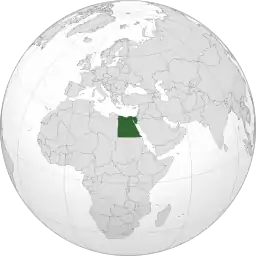Arab Republic of Egypt (1953–1958)
The Arab Republic of Egypt, was a state forged in 1953 under the rule of Mohammed Naguib following the Egyptian Revolution of 1952 in which the Kingdom of Egypt's Muhammad Ali Dynasty came to an end.
Arab Republic of Egypt جمهورية مصر العربية | |||||||||||
|---|---|---|---|---|---|---|---|---|---|---|---|
| 1953–1958 | |||||||||||
 | |||||||||||
| Capital and largest city | Cairo | ||||||||||
| Official languages | Arabic | ||||||||||
| Recognised national languages | Egyptian Arabic | ||||||||||
| Religion | Islam | ||||||||||
| Demonym(s) | Egyptian | ||||||||||
| Government | Military Republic | ||||||||||
| President | |||||||||||
• 1953–1954 | Mohamed Naguib | ||||||||||
• 1954–1958 | Gamal Abdel Nasser | ||||||||||
| Historical era | Arab Cold War | ||||||||||
| 18 June 1953 | |||||||||||
| 23 July 1952 | |||||||||||
| 29 October 1956 – 7 November 1956 | |||||||||||
| 22 February 1958 | |||||||||||
| Area | |||||||||||
• Total | 1,010,408 km2 (390,121 sq mi) | ||||||||||
| Population | |||||||||||
• 1953 | 22,028,134 | ||||||||||
• 1955 | 23,223,124 | ||||||||||
• 1958 | 25,209,459 | ||||||||||
| Currency | Egyptian Pound | ||||||||||
| ISO 3166 code | EG | ||||||||||
| |||||||||||
| Today part of | |||||||||||
The territory of the state compromised modern day Egypt as well as the Gaza Strip, governed by the All-Palestine Protectorate.
The Revolution
The Free Officers
The Arab Republic of Egypt was created following the Egyptian Revolution of 1952 led by the Free Officers, a group of Army Officers who wanted to overthrow King Farouk and abolish the Muhammad Ali Dynasty in Egypt which was led by Mohamed Naguib.
The Free Officers's goals were to Abolish the Kingdom of Egypt, to establish a Republic, end the British Occupation of Egypt including the Suez Canal, and to secure the independence of Sudan from the British which governed it as Anglo-Egyptian Sudan. The revolutionary government adopted a staunchly nationalist, anti-imperialist agenda, which came to be expressed chiefly through Arab nationalism, and international non-alignment.
The Coup
By the 25th of July, the army had occupied Alexandria, where the King was in residence at the Montaza Palace. Terrified, Farouk abandoned Montaza and fled to Ras Al-Teen Palace on the waterfront. Naguib ordered the captain of Farouk's yacht, al-Mahrusa, not to sail without orders from the army.
Debate broke out among the Free Officers concerning the fate of the deposed King. While some (including Gen. Naguib and Nasser) thought that the best course of action was to send him into exile, others argued that he should be put on trial or executed. Finally, the order came for Farouk to abdicate in favour of his son, Crown Prince Ahmed Fuad – who was acceded to the throne as King Fuad II – and a three-man Regency Council was appointed. The Former King's departure into Exile came on Saturday, 26 July 1952 and at 6 o'clock that evening he set sail for Italy with protection from the Egyptian army. On 28 July 1953, Muhammad Naguib became the first President of Egypt, which marked the beginning of modern Egyptian Governance.
.svg.png.webp)
History
Naguib presidency (1953–1954)
Following the 1952 Revolution by the Free Officers Movement, the rule of Egypt passed to Military hands and all political parties were banned. On 18 June 1953, the Egyptian Republic was declared, with General Muhammad Naguib as the first President of the Republic, serving in that capacity for a little under one and a half years.
Nasser presidency (1954–1958)
Naguib was forced to resign in 1954 by Gamal Abdel Nasser – a Pan-Arabist and the main architect of the 1952 movement – and was later put under house arrest. After Naguib's resignation, the position of President was vacant until the election of Gamal Abdel Nasser in 1956.
In October 1954, Egypt and the British Empire agreed to abolish the Anglo-Egyptian Condominium Agreement of 1899 and grant Sudan independence to become the Republic of The Sudan; the agreement came into force on 1 January 1956.
Nasser assumed Power as president in June 1956. British forces completed their withdrawal from the occupied Suez Canal Zone on 13 June 1956. He nationalised the Suez Canal on 26 July 1956; his hostile approach towards Israel and economic nationalism prompted the beginning of the Second Arab-Israeli War (Suez Crisis), in which Israel (with support from France and the United Kingdom) occupied the Sinai peninsula and the Canal. The war came to an end because of USA and USSR diplomatic intervention and the status quo was restored.
Suez Crisis (1956)
On 29 October, Israel invaded the Egyptian Sinai. Britain and France issued a joint ultimatum to cease fire, which was ignored. On 5 November, Britain and France landed paratroopers along the Suez Canal. While the Egyptian forces were defeated, they had blocked the Canal to all shipping. It later became clear that Israel, France and Britain had conspired to plan out the invasion. The three allies had attained a number of their military objectives, but the Canal was useless. Heavy political pressure from the United States and the USSR led to a withdrawal. U.S. President Dwight D. Eisenhower had strongly warned Britain not to invade; he threatened serious damage to the British financial system by selling the US government's Pound Sterling bonds. Historians conclude the Crisis "signified the end of Great Britain's role as one of the world's major powers".
The formation of the United Arab Republic (1958)
In 1958, Egypt and Syria formed a sovereign union known as the United Arab Republic, ending the Arab Republic of Egypt.
.svg.png.webp)
.svg.png.webp)